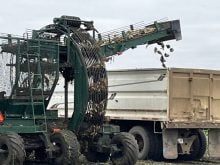REDWATER, Alta. – After spending hours painting, repainting, flooding and reflooding the sheets of ice at his local curling club, Kevin Grumetza thought there had to be a better way to make a curling rink.
It was during the middle of the night after a late night painting session that the part-time farmer came up with his idea of the printed rink liner.
“I thought this isn’t fun any more. There has to be a better way,” said Grumetza of Thorhild, Alta.
Grumetza first envisioned a gigantic roll of paper towel. He knew it had to be white and knew it needed to be made of mesh to let the water and cold through.
Read Also

Accurate accounting, inventory records are important
Maintaining detailed accounting and inventory records is not just a best practice; it’s a critical component of financial health, operational efficiency and compliance with programs like AgriStability.
Two years later, almost 100 curling rinks and one hockey arena from Alberta to Italy have thrown away their paintbrush and replaced it with his mesh rink liner.
Dave McRae, project manager for the town of Redwater, estimates they will save 60 percent of the usual cost of ice installation by using rink liners in both the arena and curling rink at the town’s Provident Place multi-use facility.
Instead of spending two weeks painting lines on the three sheets of ice at Redwater’s curling rink, the reusable rink liners were rolled out in 11 minutes. By the next day, curlers were on the ice.
It took seven hours to place, cut and tack the 11 pieces of rink liner in the 1,530 sq. metre hockey arena and three days to make the ice instead of the usual two weeks.
“Right now I’m very, very happy, not only with the installation price but the ongoing product capability,” said McRae.
The rink liner looks like a large sheet of Aida cloth, the same open-weave material used in cross stitching or hooked rugs. Grumetza said one of the biggest challenges was convincing a printer to take on the monumental task of printing the long mesh sheets.
Now that it’s developed, the biggest comment is why anyone didn’t think of this before, said Grumetza, who operates Hack-to-Hack Solutions and Goal-to-Goal Solutions. He already has orders for seven hockey rinks and 200 curling rinks next year.
One of the biggest benefits Grumetza sees is not having tonnes of paint, traditionally mixed into the ice, washed down the drain each spring or pushed out onto the parking lot and allowed to seep into the sewer system.
“It’s so much more environmentally friendly,” he said.
At the end of the season, the ice plant is turned off, the ice melts and the cloth is dried and rolled up until the next winter.
“It’s a very versatile product,” said McRae who has been contracted by several surrounding municipalities and small towns to analyze the liners and report back.
McRae said the mesh lets the cold through easier so that the temperature of the ice making equipment doesn’t need to be as cold and a solid ice surface can be made with less water.
“The ice seems to get very hard, very fast,” said McRae.
For curlers and hockey players, it’s a colder, keener ice, said Grumetza.
McRae said initially there was skepticism by skaters and hockey players who needed to be convinced the ice surface would be the same. The skaters would walk out on the ice like Bambi testing the ice.
“We’ve had no complaints from figure skaters or hockey players.”
This spring McRae wants to simulate a compressor failure, a common occurrence with older ice making plants. When the ice plant quits, usually the mixture of ice and paint breaks apart in clumps and the arena manager has no choice but to remove the ice and start again.
With the rink liner, the ice is simply refrozen without having to start the process from scratch, said Grumetza, who knows from experience after the Waskatenau ice plant quit twice last season.
The material seems to be durable. Last season, during the first year of use, vandals broke into the Redwater arena and poured gasoline and sprayed fire extinguishers on the ice. Neither products or the iron filings and concrete dust in the air from the ongoing construction seemed to affect the liners.
“It’s very durable and very, very dependable,” said McRae.
Grumetza is beginning to print six sheets for an oilman’s bonspiel at Rocky Mountain House, Alta. With more than 100 teams entered there aren’t enough regular curling sheets in town. Using rink liners, an extra six curling sheets will be made on the hockey rink at the end of the hockey season.
Each $4,000 liner at the bonspiel has already been bought and paid for by advertisers. Advertising logos are either printed directly on the mesh or laid over top of the mesh or melted in the ice with overlay.
Two years ago the NHL moved the goal line away from the boards and the blue line towards centre. If more changes are made, adjustments are easily made with a new mesh overlay, said Grumetza.
Don Lakusta of Opal, just north of Redwater, is one of the first people to use the curling rink liners on his backyard rink on his elk and bison farm.
For 11 years, Lakusta faithfully painted curling circles on his backyard rink for the annual New Year’s Eve bonspiel. He now has two custom-made rink liners on the combination hockey and curling rink.
“It certainly makes life a lot easier,” said Lakusta.
In the spring when the sun hits the ice, the coloured circles used to bleed and clump in odd shapes, making hitting the button more challenging.
Lakusta said it’s still a lot of work flooding the ice and keeping it clear of snow, but when his family comes for its annual Christmas Eve hockey tournament or neighbours play till 3 a.m. at the New Year’s Eve bonspiel, it’s worthwhile.
“When the kids are out there playing, that’s what it’s all about.”














